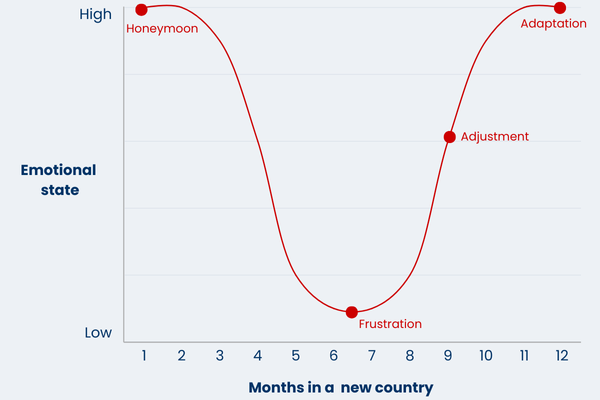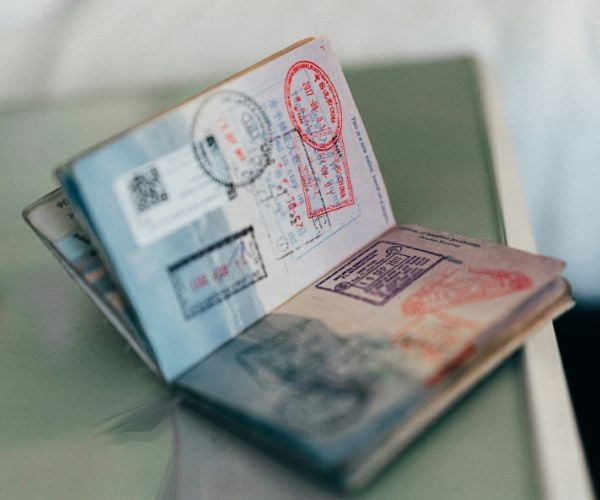Before packing, check this list of items prohibited from entering a particular country or region.
Key takeaways
- Culture shock is the feeling of disorientation or discomfort people experience when exposed to a new and unfamiliar culture.
- Culture shock examples include language barriers, unfamiliar transport systems, new forms of etiquette, and different dress codes.
- To deal with culture shock, remain patient and avoid comparing things to what you're used to back home.
- The stages of culture shock are the honeymoon period, followed by frustration, adjustment and adaptation.
What is culture shock?
Culture shock is the feeling of disorientation or discomfort people experience when exposed to a new and unfamiliar culture. It often occurs when a person moves to a different country, region, or community where customs, language, social norms, and even daily routines differ significantly from what they are used to.
At its core, culture shock is about adapting to a new way of life, and it can bring a mix of emotions, from excitement and curiosity to frustration and homesickness. The experience is highly personal, as some expats adapt quickly while others take more time to adjust.

Culture shock examples
Culture shock examples include language barriers, unfamiliar transport systems, new forms of etiquette, and different dress codes. For example, someone travelling from the UK to Japan for the first time might struggle with the country's strict etiquette, such as bowing instead of shaking hands or removing shoes before entering homes.
Below we look at common types culture shock in more details:
- Language barriers: struggling to greet neighbours or communicate on public services can lead to misunderstandings.
- Dining customs: unfamiliar food and drink, late or early eating times or the lack of comforting options.
- Public transportation: navigating the unspoken etiquette on trains, buses and subways, such as queuing or silent carriages.
- Social interactions: knowing when to use formal or informal greetings, personal space, correct handshakes, eye contact and preferred pronouns.
- Driving rules: driving on the opposite side of the road or understanding different laws and traffic signs.
- Dress codes: understanding appearance expectations, such as modest clothing and visible tattoos.
- Workplace culture: professional hierarchies, meeting structures or work-life balance differences.
- Public displays of affection: in some cultures, romantic gestures, such as holding hands or kissing, may be inappropriate.
- Living arrangements: adjusting to different housing types, such as shared accommodations, smaller living spaces, and lack of heating or air conditioning.
- Bargaining and tipping: learning when and how to negotiate prices or the proper tipping etiquette.
- Family dynamics: navigating different family structures, including expected living arrangements or the role of elders in decision-making.
- Health and hygiene: getting used to different healthcare systems, sanitation practices or personal hygiene norms.

Symptoms of culture shock
The following is a list of common symptoms when encountering culture shock:
- Feeling overwhelmed and stressed while adjusting to local norms, languages, or behaviours.
- Becoming easily irritated by differences in culture or customs.
- Missing friends and family, familiar places or routines from home.
- Feeling isolated or disconnected.
- Experiencing physical fatigue or emotional exhaustion from constant adjustment.
- A loss of confidence from doubting your ability to navigate the new environment effectively.
- Feeling nervous or uncertain in unfamiliar situations.
- Avoiding interaction with locals or engaging minimally with the new culture.
- A lack of enthusiasm for exploring.
- Headaches, stomach issues, or sleep disturbances related to stress.
- Romanticising your home country and overlooking its flaws.
6 cultural differences from around the world

How to deal with culture shock
To deal with culture shock, remain patient and avoid comparing things to what you're used to back home. Most people go through similar phases when encountering a new way of life, so the best thing you can do is give it time.
Another effective method is to learn about the local culture's customs, traditions and everyday language before you arrive. Doing so helps you build rapport with people quicker and avoid misunderstandings. Why not create a support system by connecting with fellow expats via clubs and online groups? Shared experiences can help you feel more at home and less isolated.
Practising self-care is also essential, whether it's exercising daily, eating well, finding a quiet space to relax or indulging in your favourite hobbies. Making time for yourself helps ease stress and maintain a sense of identity.

What is reverse culture shock?
Reverse culture shock is when you return to your home country after an extended period abroad and find it difficult to readjust. You may have developed new habits, perspectives and values that are out of place in your home culture. For example, you might find the pace of life more frantic than you remember or struggle with societal norms that now seem restrictive.
Perhaps you've returned from a country that emphasised community and now find your home culture's individualistic nature jarring. You might have adopted new dietary preferences, ways of communicating or attitudes towards work-life balance that now feel out of step.
Such disconnection can lead to confusion, alienation, frustration, or even an existential crisis! You might experience nostalgia for the culture you left behind or a sense of not fully belonging in either culture, leaving you feeling 'in-between'.
Here are some practical tips to manage reverse culture shock:
- Stay connected with the culture you left behind: keep in touch with your new friends, engage in cultural activities or cook dishes from that cuisine.
- Share your experiences: find people who share your new cultural interests or have also experienced reverse culture shock.
- Give yourself time: readjusting takes time, so be patient and allow plenty of time to heal.
- Reflect on how you've changed: journaling or discussing your experiences with a close friend or therapist can help process the changes you've been through and how they fit into your current life.
"There is nothing like returning to a place that remains unchanged to find the ways in which you yourself have altered." - Nelson Mandela
Stages of culture shock
The stages of culture shock are the honeymoon period, followed by frustration, adjustment and adaptation.
Here are the four stages of culture shock and their timelines:
- The honeymoon period (the first 6-12 weeks): during your first handful of months in a new country, everything feels exciting, much like an extended holiday. The brand-new surroundings, interesting culture and variety of experiences are fascinating. You may also have high expectations and feel motivated by a 'let's make this work' mindset, which can help gloss over any initial doubts.
- Frustration (months 3 to 6): once the novelty of your new life starts to wear off, things that once seemed charming or delightful may now appear strange or difficult. Language barriers, unusual foods and confusing social norms can trigger frustration and feelings of anger or sadness. Homesickness may set in as you long for the familiarity and comfort of your life back home.
- Adjustment (6 to 10 months in): eventually, you'll understand the locals' language, customs, and quirks more clearly. Daily activities, such as shopping, communicating, and understanding social cues, start feeling easy and natural. Friendships with locals or fellow expats begin to form, helping foster a sense of belonging for the first time.
- Adaptation (after 1 year): by now, cultural differences no longer feel jarring, and you've learned to navigate the environment confidently. The sense of alienation fades, and you start to feel like an accepted community member. While homesickness or nostalgia for your old life may remain, they are no longer overwhelming.
The culture shock curve













